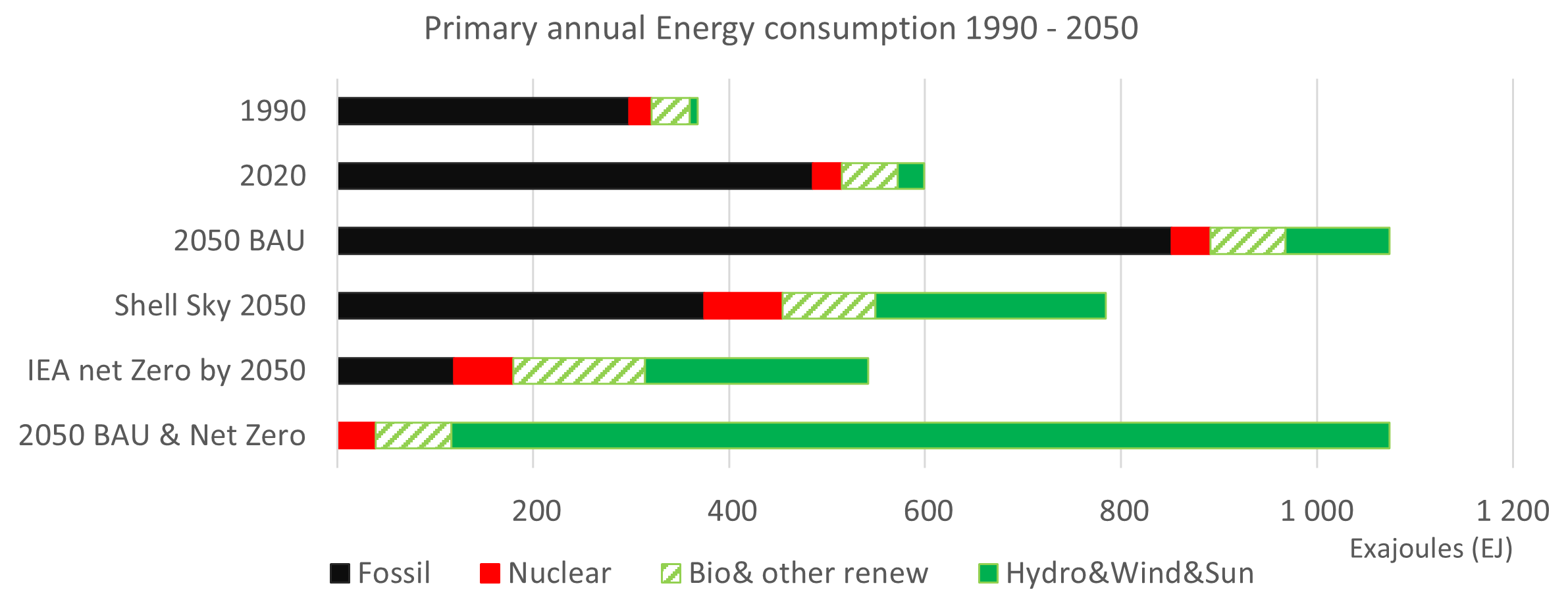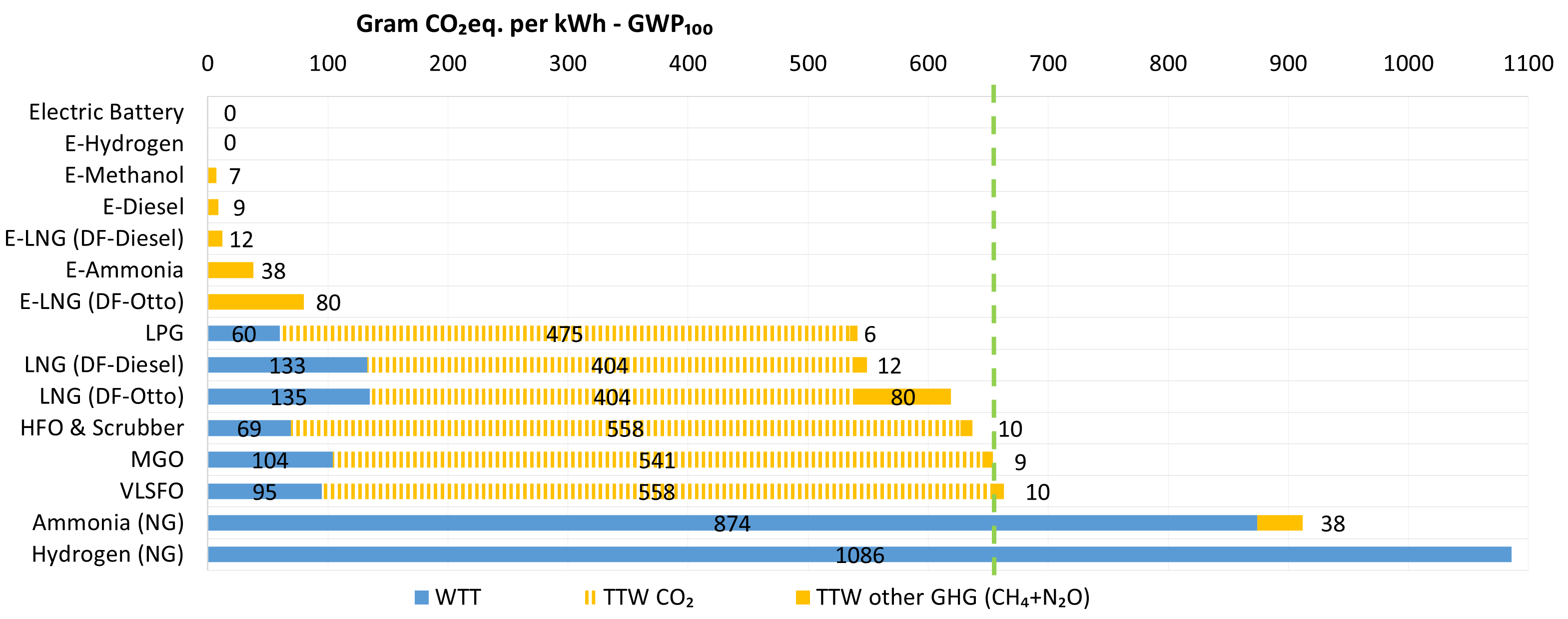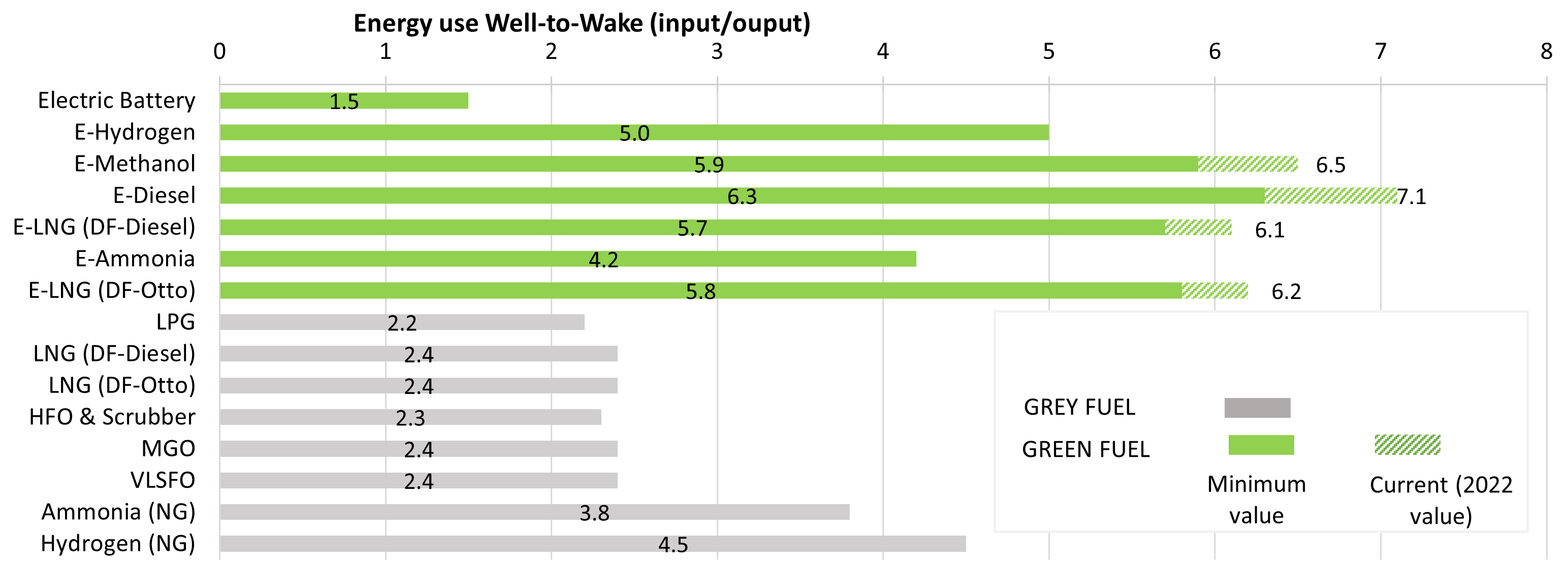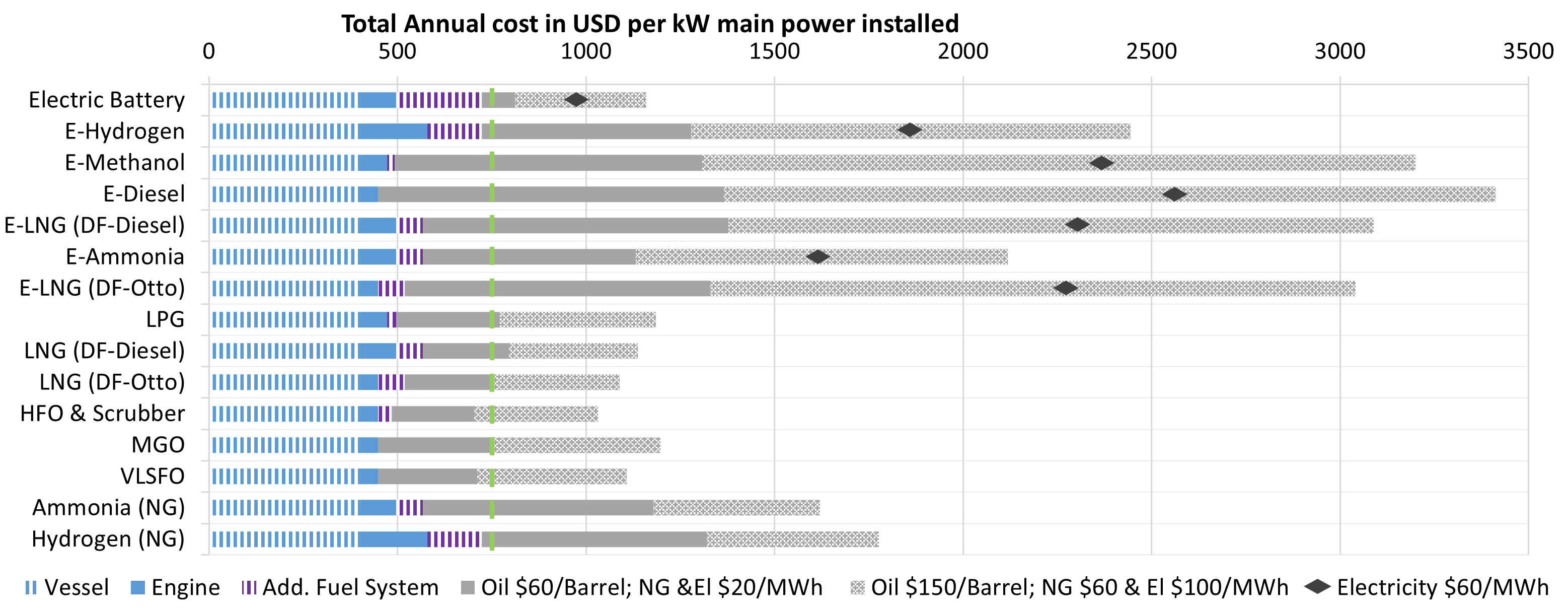From the first days of our civilization maritime transport has dominated trades between nations, regions, and continents. Today, maritime transport accounts for 80% of the Global trade measured in ton miles and 3% of global Greenhouse gas (GHG) emissions. The Intergovernmental Panel on Climate Change stress the urgent need for rapidly reducing Global GHG to mitigate global warming and to reach Net Zero GHG within a few decades. The term net zero imply that all remaining anthropogenic GHG emissions will have to be offset with carbon removal from the atmosphere.
In that perspective, a rapid de-carbonization of the whole transport sector is often seen as necessity to mitigate global warming. That view is strongly advocated by the International Energy Agency (IEA) in its “Net Zero by 2050” scenario, published in May 2021. Conversely, in their 2021 “Sky” scenario, Shell brings us to Net Zero by 2070 picking the lowest hanging fruits first and implying a continuous use of fossil fuel both for maritime and aviation. To reach Net Zero, both IEA and Shell need technical removal of carbon from the atmosphere in the form of Carbon Capture and Storage (CCS) to offset the remaining fossil use in 2050, as shown in Figure 1.
The term net zero imply that all remaining anthropogenic GHG emissions will have to be offset with carbon removal from the atmosphere.
To increase renewable energy production fast enough to achieve the require demand is an enormous challenge. Both IEA and Shell do foresee that the renewable production has the potential to increase 2.5 – 3 times faster than under a Business-as-usual (BAU) scenario. Still, if our society shall be fully decarbonized by 2050 without CCS, the annual renewable electricity production must increase by up to 30 exajoules, namely four to five times faster than what IEA and Shell predict as illustrated by the bottom-line bar in Figure 1.

To increase renewable energy production fast enough to achieve the required demand is an enormous challenge.
Zero carbon fuels, made from renewable sources (hydro, wind or solar), are by many seen as a promising option for maritime transport to deliver the desired GHG reductions. Applied to maritime transport these fuels come in two forms: either as E-Hydrogen or E-Ammonia, which requires new vessels and supply infrastructures or conversions of existing ones; or, as hydrocarbon E-fuels in the form of E-Diesel or E-LNG, which are fully blendable with their fossil counterparts such as MGO and LNG and can be used on existing vessels without any modifications or any new infrastructure. By definition all fuels produced by renewable electricity are ‘E-fuels’ (electro-fuels). In addition to E-Diesel and E-LNG, also E-Methanol has gained interest as a future fuel for the maritime sector. Methanol is a liquid fuel that can be stored in a similar manner to Diesel fuels.
Low Carbon fuels is a term used for both Biofuels and fossil fuels which have lower GHG emissions per energy unit than the conventional diesel (MGO) or bunker oil (HFO, VLSFO). Compared to fossil fuels, the difference in biofuels’ well-to-tank emissions is of much larger scale due to their different source of origins and the indirect effects on land use. For example, while Biogas made from waste might be close to zero in GHG emissions, Biodiesel made from Palm oil can potentially more than double the emissions compared to the fossil fuels. LNG and LPG made from fossil sources are often considered as low GHG fuels, since they have 15 – 20 % lower GHG emissions than conventional fuels, when burnt in diesel dual fuel engines on a Well-to-Wake scale.
Electric batteries: For shorter crossings, renewable electricity from hydro, solar or wind can in combination with on-board batteries enable both fjord crossings by car-ferries and soon shorter international ones with a duration of a few hours by Ro-Pax vessels.
Numerous articles have been published both in the scientific press and in the popular press about the environmental advantage of E-fuels compared to conventional fuels focusing on their GHG reduction potential, often neglecting that their production requires large amount of renewable energy. From a narrow perspective and considering maritime transport as an island on its own following the argument that all sectors shall take an equal share of the GHG reductions, one can certainly argue that the way the various zero and low carbon fuels influence global energy usage (consumption) is irrelevant. However, despite that climate change came on the agenda in the 1990’s, global energy consumption has increased from 380 exajoules in 1990 to around 600EJ in 2020 as shown in Figure 1. Our resources are not unlimited, and we should neither waste them nor take them for granted.
The discussion around The environmental advantage of E-fuels compared to conventional fuels is mainly focused on their GHG reduction potential, often neglecting that their production requires large amount of renewable energy.
In a paper presented at SMC-2021 with the title Assessment of Alternative Fuels and Engine Technologies to reduce GHG (Elizabeth Lindstad, Gunnar M. Gamlem, Agathe Rialland, Anders Valland) Energy use and Cost were included in addition to the GHG emissions of the assessed fuels. Less than a year after this paper was written, major natural and geopolitical changes have arisen, making the energy use dimension even more important than ever before. First, during the summer and autumn of 2021, Europe experienced much less wind and less rain than usual, which gave a shortfall in renewable electricity production at the same time as more electricity was required for air-conditioning due to a warmer summer. This in combination with closure of nuclear power as part of greening policies and un-certainties regarding supply of Russian gas supplies to Europe Union peaked European energy prices even before the Russian attack on Ukraine on the 24th of February 2022. Similarly, US-weather has also become more unstable with following shortfalls of renewable electricity production.
Our resources are not unlimited, and we should neither waste them nor take them for granted.
In light of the above, an update to the previous Cost-, GHG-, Energy use- assessment of alternative fuels and engine technologies (Lindstad et al., 2021) is necessary: First, the list of options is expanded to include the fully electric option, i.e. a ship with a battery large enough to operate in Short Sea Shipping trades up to 200nm, and with sufficient diesel generator capacity as a range- and safety backup; Second, with the potential food shortage foreseen due to the attack on Ukraine, food production will get the priority and even less farmland can be used to produce biofuels; Third, the price range for renewable electricity is expended from 20 – 60 USD per MWh to a 20 – 100 USD range, in which a level of around 60 USD in average per MWh reflects what is needed for new production capacity to secure a viable rate of return; Fourth instead of using fixed prices for the fossil energy, crude oil and natural gas, a price range of 20 – 60 USD per MWh is used for natural gas and 60 – 150 USD per barrel is used for the crude oil.
The GHG-, cost-, and fuel consumption is estimated per MW of main power installed on board the vessel, instead of divided into different ship segments, with an estimated annual fuel consumption of 600 ton of oil equivalent (TOE) per MW. All figures are Well-to-Wake including both the production of the fuel and its combustion on-board the vessels. Using MGO as an example, when running a two-stroke Diesel engine on MGO with 50 % average thermal energy efficiency, the engine must be feed with 2 energy units to deliver 1 unit at the propeller. When adding the production of the MGO (the well, the production rig, transport, refining and final distribution to ships) that implies that to deliver 1 energy unit on the propeller we use 2.4 energy units on a Well-to-Wake basis.
An update to the previous Cost-, GHG-, Energy use- assessment of alternative fuels and engine technologies is necessary.



Figure: 2 Comparing GHG emissions, Energy use and Cost of alternative maritime fuels.
The main observations from Figure 2 are: First, E-fuels reduces GHG emissions with up to 100% compared to fossil fuels; Second, the production of these E-fuels are energy demanding and if they are fully deployed in maritime transport it will for E-Hydrogen and E-ammonia double the maritime transport’s share of global energy usage from around 3% to 6% and with Hydrocarbon E-fuels it will nearly triple to 9%; Third E-fuels are costly to produce and even with quite moderate electricity prices, i.e., around 60 USD/MWh the total annual cost of a vessel will double with E-Hydrogen and E-ammonia and triple with E-LNG, E-Methanol and E-diesel.
As an example, a Dry Bulk Supramax vessels (63 000dwt) comes at a total annual cost of around 6 MUSD when operated at conventional fuels (Capex + Opex + Fuel), around 12 MUSD on Hydrogen or E-ammonia and around 18 MUSD on E-LNG, E-Methanol and E-Diesel. With the historic large volatility in freight prices the market might still accept to pay the higher freight rates. More importantly with the foreseen constant shortage of renewable energy up to 2050, a core question to ask, can we get larger GHG reductions if we use the renewable energy within other sectors“. Basically, the advice of Shell which prescribes us to pick the low-hanging fruits first. According to the fourth IMO GHG study maritime transport emitted 1 056 million ton of CO2 in 2018 from burning around 330 million ton of fuel, which converts to 14 Exajoules. Simply assuming same thermal engine efficiency with E-fuels as with the traditional fuels the amount of renewable electricity required are:
E-ammonia: 14EJ * 4.2/2 = 29EJ; E-diesel: 14EJ * 7.1/2 = 50EJ
Basically, the 29EJ is of the same magnitude as today’s Global renewable electricity production, and which also is of the same magnitude as the amount needed if we shall replace Global coal fired electricity production. Moreover, when the first 29EJ has replaced coal fired electricity generation, the next 21EJ will be sufficient to replace all electricity production based on natural gas. Figure 3 illustrates the GHG reduction potential of using 29 – 50EJ on producing E-fuels for shipping versus using it on decarbonizing global electricity production.

The low estimate is here based on that E-Ammonia becomes the chosen fuel and the high on E-diesel becoming the fuel. When the difference between high and low in CO2eq. terms is less than the difference in energy usage it’s because we get larger CO2eq. reductions when replacing coal than gas in the electricity generation. Anyhow with renewable electricity foreseen to be a scare resource up to 2050, we cannot afford to waste it on producing E-fuels for maritime transport if global warming shall be stopped. Simply because we get 7 to 10 times larger GHG reductions when we use renewable energy on de-carbonizing the electricity sector compared to using it on making E-fuels for shipping. In addition, for E-ammonia which here represents the low bound, the multiple is larger than 7, due to large GHG emissions from building up the required fuel distribution infrastructure, in addition to all the health and safety concerns when handling ammonia in ports and on ships in general.








Comments
Thanks for the observations and the comments. I will try to answer:
– First, I fully agree that there are capacity limits on how much biofuels we can produce and how large areas which can be used for Solar parks or for Wind farms
– Second, CCS does not come free of charge, and even if some can be pumped down into oil & gas fields storage capacity will soon become a challenge. Therefor we will be much better off burning much less, fossil fuels.
– Third, a society with a high degree of renewables will have to use large amount of intermediate energy storage such as in batteries due to that it’s not always wind, and sun parks cannot produce during the night.
Fourth, the hard to abate sectors can most effectively be abated through market-based measures, i.e., paying other sectors for making the reductions.
Fifth, can we continue to live like today. Challenging question and my answer are that we in any case have to stop wasting and instead use our resources more carefully
Thank you for a very interesting article triggering some important reflections around electricity generation and how to prioritize green energy. I encourage you in SINTEF to do more of these global assessments where the global challenge is attacked with hard facts and numbers. For example: How many acres of forest must be used annually to produce enough biofuels, how many square kilometres must be used for PV and wind power, and what will the cost be? CCS is probably going to be part of the solution, but where do we start harvesting and where do we store the captured CO2 permanently for which cost?
As a final remark, some rhetoric questions our nation needs to solve:
*The “hard to abate” sectors are going to be challenging to mitigate to get to net zero anthropogenic emissions, so how can it be done assuming we will still keep them?
* Societies based on renewables will always struggle with intermittency, i.e. unpredictable and uneven production of energy triggering a need for unrealistic(?) large and expensive energy storage systems when the wind isn’t blowing and the sun isn’t shining. Many challenges arise from that fact. For example, is it at all possible to obtain zero emissions anytime soon without nuclear power production ?
* Is it at all possible to obtain zero emissions without changing the way we live and how we utilise our global resources?
I don’t think it is possible to continue living as we do today…